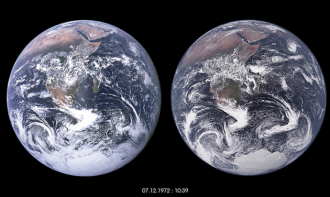| ← prev Imprecise, not inaccurate, weather forecasting |
Contents |
next → Tim’s adventures in quantum mechanics |

Bjorn Stevens
Max Planck Institute for Meteorology, Hamburg, Germany
Fifteen years ago the climate science community was buzzing in anticipation of a “World Modelling Summit for Climate Prediction”, which was being organized at the ECMWF for May in the forthcoming year. The summit was the brain child of Jagadish Shukla and Tim Palmer, and had support from a veritable who’s who of the climate modelling community, among them Julia Slingo, the Met Offices Chief Scientist, and Jochem Marotzke of my own institute. Shukla and Palmer took the lead in drafting the workshop report, which they shaped into a paper entitled “Toward a new generation of world climate research and computing facilities". It appeared in the Bulletin of the American Meteorological Society a couple of years later. The report’s recommendations have yet to be taken up.
For some people, the report’s vision — of scientists working together in one or more international centers to provide the best climate information possible, particularly for vulnerable sectors and communities most exposed to the wrath of the climate system — faded in the resignation borne of inaction. The support of others waned from the fear that articulating an ambition for our science might communicate uncertainty, which could call into question the then fragile scientific consensus as to the pace and cause of global warming. I like to think that Tim’s deep seated belief in the power of our science, and his first-hand knowledge of what it meant to work together with a common vision, is what made him impervious to such fears.
Whatever the reason, no other person has done so much to keep the embers of the summit alive over the past years — in ways which now seem to be catching fire. In 2014 Tim proposed that I join him to organize a workshop under the auspices of the Royal Society, at Chicheley Hall. The workshop gave birth to the idea of a European Programme for Extreme Computing and Climate (EPECC). EPECC sprang to life around an articulation by Sandrine Bony of the CNRS, who recognized that without substantial advances in computing, it would be impossible to understand drivers of extremes, and how they might change. In response to a European Call for Flagship Programmes on Future and Emerging Technologies, EPECC merged with an observation based effort called Ultimate Earth, to become Extreme Earth. Tim, together with myself, Peter Bauer, Giardini Domenico, Wilco Hazeleger, Markku Kulmala, Thomas Schulthess and others developed Extreme Earth from what was initially a computational aspiration to what became a platform to advance emerging information technologies to allow more intuitive and effortless access to data and model output. Peter Bauer led the effort, something that only became possible after Tim, Thomas Schulthess and myself made the case for ECWMF’s involvement, through Peter Bauer’s deeper engagement. When the Flagships were discontinued, Extreme Earth’s vision lived on to animate what has now become Destination Earth.
In the meantime, Tim has remained an articulate and forceful advocate for an international center or centers to wed climate information systems with advances in information technology in ways that would support vulnerable communities and give the ideas animating Destination Earth some permanence. As the chorus rises, and more of us (see Slingo et al., “Ambitious partnership needed for reliable climate prediction”, Nature Climate Change 2022) appreciate the imperative to work together to bring forth more reliable climate predictions, we should remain sensitive to one of our finest voices. Particularly as these ideas have now come full circle. The day when I write this, a day after Tim’s symposium, marks the 50th anniversary of the photograph known as the Blue Marble. One of the most iconic photographs ever taken, it shows the fully illuminated Earth, as seen by the astronauts aboard Apollo 17, looking back on what was to be the last crewed mission to the Moon. To commemorate this day, and how it signifies what can be borne of collective effort, my institute simulated the coupled climate system, with the atmosphere initialized from an ECMWF reanalysis of the meteorological conditions 48 hours prior to the famous photograph. The simulations are performed with the type of model that was envisioned by the World Modelling Summit, with a 1 km grid in both the atmosphere and ocean. This capability finally realizes a long held dream of climate scientists, one that motivates Destination Earth and which many of us, not the least Tim, feel holds the key to more reliable climate projections, particularly at the regional scales where adaptation efforts remain ill-informed.

Had we followed the advice of Shukla, Palmer and colleagues, the capacity that we can now begin to demonstrate would be much further developed. Simulations like the ones this image visualizes, would now be operational, with a computational throughput 2-3 orders of magnitude larger than what we, in the meantime, just managed.
7 December 2022
| ← prev Imprecise, not inaccurate, weather forecasting |
↑ top | next → Tim’s adventures in quantum mechanics |
